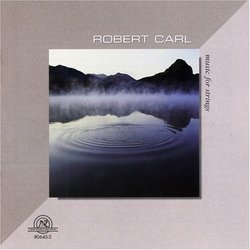| All Artists: Adaskin String Trio Title: Robert Carl: Music For Strings Members Wishing: 0 Total Copies: 0 Label: New World Records Original Release Date: 3/1/2006 Release Date: 3/1/2006 Genre: Classical Styles: Chamber Music, Historical Periods, Classical (c.1770-1830) Number of Discs: 1 SwapaCD Credits: 1 UPC: 093228064527 |
Search - Adaskin String Trio :: Robert Carl: Music For Strings
 | Adaskin String Trio Robert Carl: Music For Strings Genre: Classical
Robert Carl possesses one of the widest and most varied expressive ranges of any composer of his generation. This isn't the disc to prove that, however. In the string music here we focus in on what I think of as the centra... more » |
Larger Image |
CD Details
Synopsis
Product Description
Robert Carl possesses one of the widest and most varied expressive ranges of any composer of his generation. This isn't the disc to prove that, however. In the string music here we focus in on what I think of as the central core of Carl's aesthetic: the devoutly ruminative music with expression markings like "achingly" and "fragile." In his string music, Carl aligns himself with Beethoven and Ives as a composer who asks musical questions, who frankly frames his own spiritual journey in sounds with all its doubts, hungers, epiphanies, and acquiescences. At the end of Open or Carl's Second String Quartet, we know the composer's response to the existential questions of life as definitively as we can know them at the end of Ives's Fourth Symphony, or Beethoven's Ninth. Carl can be playful, satirical, intellectual, or picturesque in his other works, but something about the soulful nature of stings makes him express his innermost yearnings through them. And these three works, written within a three-year period, are even more closely related than this implies. Their motivic material seems cut from the same cloth: the imperious dotted-rhythm motive at the beginning of Open, the thirds encircling each other in the "Angel-Skating" Sonata, the leaping lines at the beginning of the Second quartet, are all based on pairs of interlocking intervals, whose contours Carl weaves into tapestries whose underlying unity is felt visceraly without being analytically contrived. Kyle Gann (from the liner notes)

 Track Listings (7) - Disc #1
Track Listings (7) - Disc #1